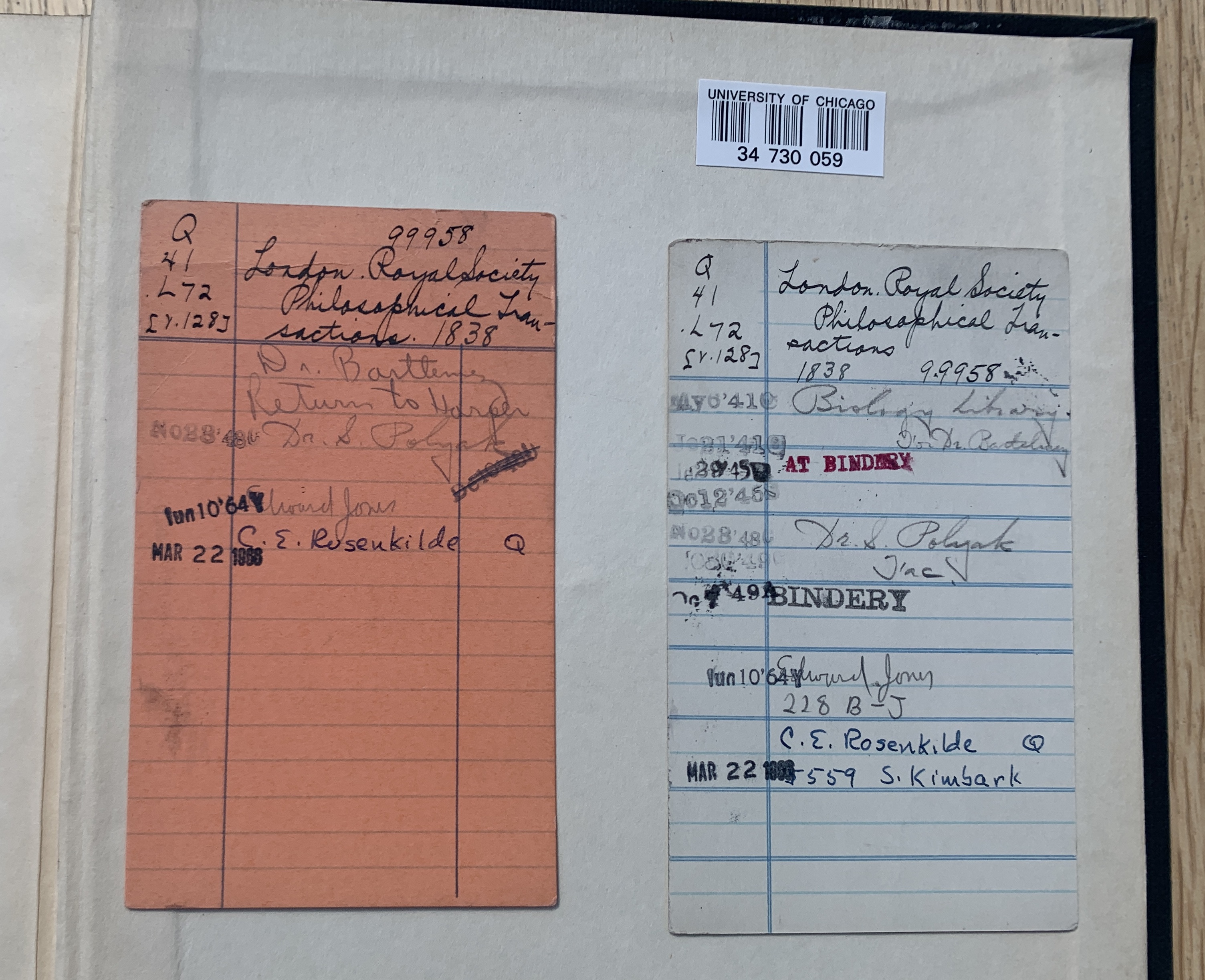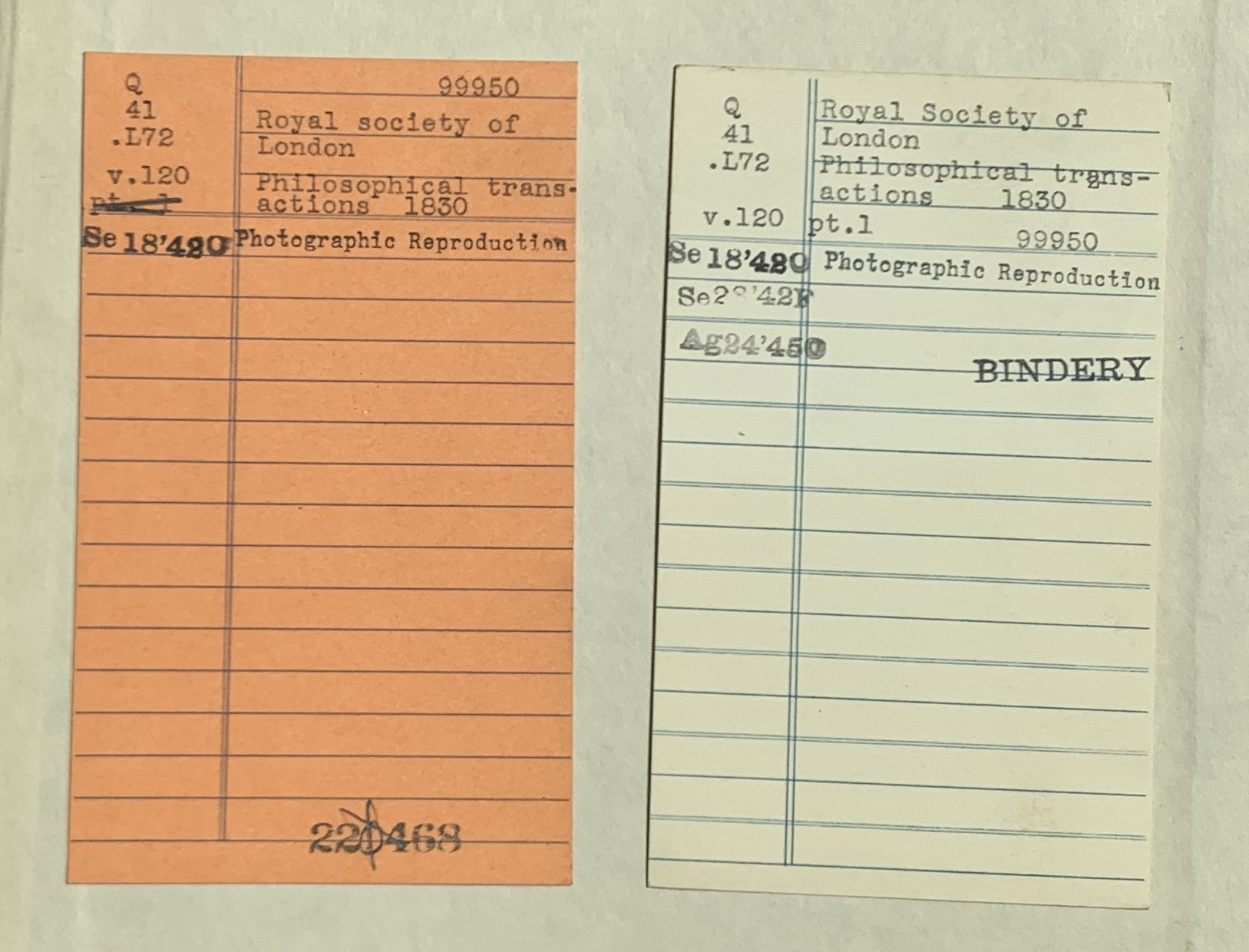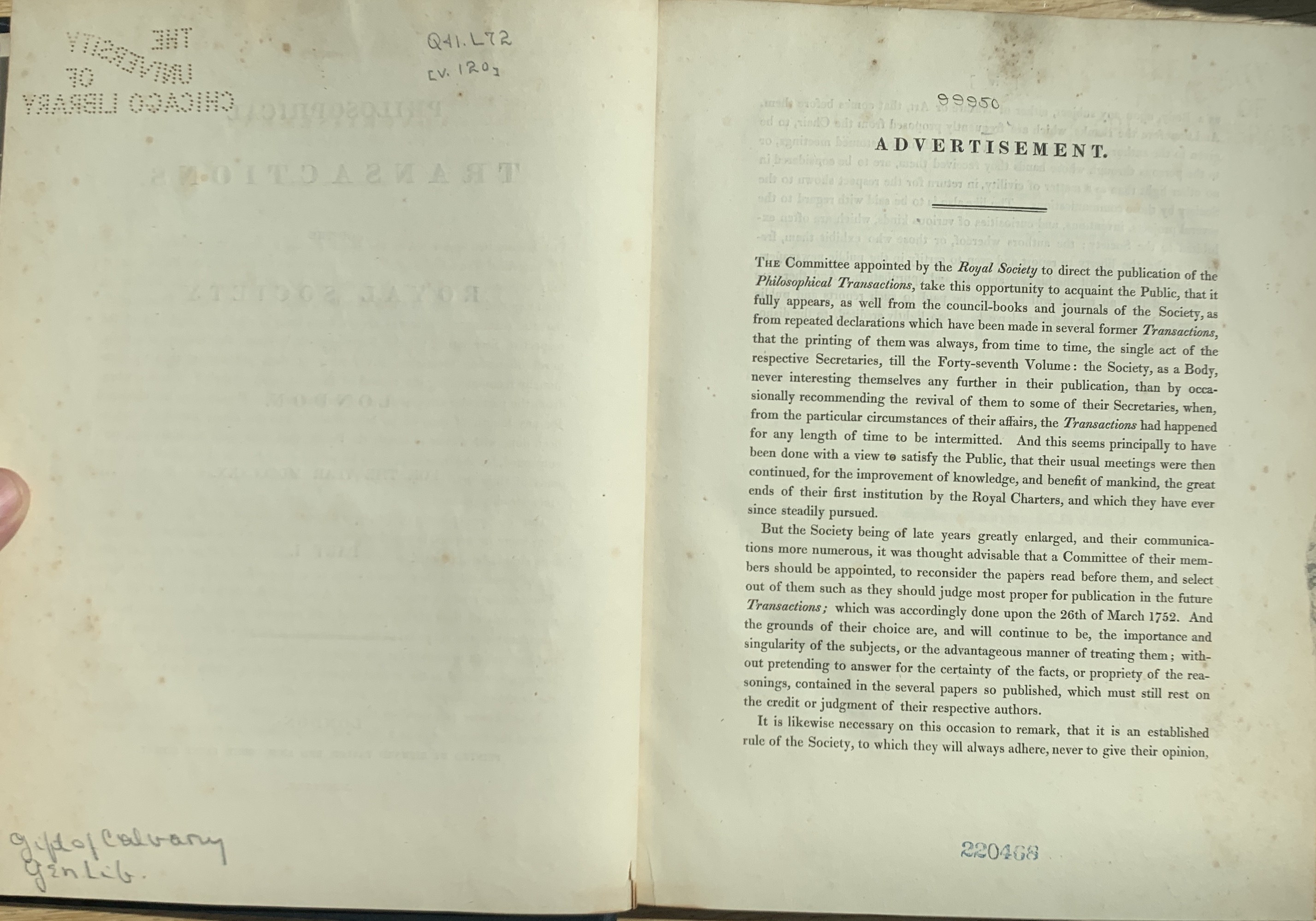I’ve been puzzling through the source of copies of the Transactions and its abridgments at he University of Chicago Library Hanna Holborn Gray Special Collections Research Center. Some of the copies remained in the circulating collection and ultimately ended up in Joe and Rika Mansueto Library, the university’s research collection.
To recap, the new university President bought the S. Calvary and Company’s entire book collection to establish the library. Over time, some volumes were withdrawn and others moved from one collection to another.
I’m grateful to Seth Vanek who helped me page a cart of books that you can see above. These are the volumes listed in the accession records that have not been withdrawn. They have a variety of different marks, but every single one has the hand-written accession number that places it within this initial acquisition from the S. Calvary and Company purchase.
Most of the volumes have been rebound in the 1940s or ’60s but a few remain in repaired bindings enclosed in boxes. The volumes have a whole history of the collection and institution written on them. Consider these circulation cards at the back of volume 128.

When it was checked-out, one of the two cards must have stayed in a file while the other stayed with the book. The white card has a stamp saying it was at the bindery in 1945 and 1949. It might have been stamped at the bindery. Other volumes have the a number stamped on this card too. Volume 120 has the number “220468” stamped on the card and on the first page of text.

And on the recto of the leaf after the title page, you can see the same number.

Since the card includes both the accession number and this new number, it must not be a replacement number, but a different record. Based on the presence on a card and the book, I’d guess it was a number for a circulation file. I’ll summarize some marks on the book in a table like I used before.
| Vol. 115 (1825) | 117 (1827) | 118 (1828) | 120 (1830) | 121 (1831) | 126 (1836) |
|---|---|---|---|---|---|
| modern blue cloth (mbc), | mbc | mbc | mbc | boxed, mbc | mbc |
| rebound on: 22 Dec 1948 | 20 Jan 1964 | 24 April 1945 | |||
| Bookplate: Institutional (I) | Berlin Collection (BC) | I | I | BC | BC |
| Accession: 99944 | 99947 | 99948 | 99950 | 99951 | 99956 |
| Stamped: 193349 | 162746 | 220467 | 220468 | 217480 | 217481 |
| Barcode: 15 407 700 | 098 732 594 | 098 878 049 | 098 878 162 | 73 407 500 | 098 878 340 |
| Peciled on t.p.: 9843 | 9843 | 9843 | 9843 | 9843 | 9843 |
| Vol. 127 (1837) | 128 (1838) | 129 (1839) | 130 (1840) | 131 (1841) | 132 (1842) |
|---|---|---|---|---|---|
| mbc | mbc | mbc | mbc | boxed, repaired 19c Ger. binding typical of this set | boxed, repaired 19c Ger. binding with differently marbled papers from the rest |
| 28 June 1945, Oct 1949 | 11 June 1945 | ||||
| Bookplate: BC | BC | I | BC | BC | I |
| Accession: 99957 | 99958 | 99959 | 99960 | 99961 | 99962 |
| Stamped: 158662 | 29720 | 215544 | 163794 | 25743 | 198920 |
| Barcode: 098 878 405 | 34 730 059 | 098 878 463 | 098 878 057 | 73 407 771 | 19 771 945 |
| Penciled on t.p.: 9843 | 9843 | 9843 | 9843 | 9843 | 9843 |
Just this small sample shows us several things. The books were mostly rebound in the ’40s, but also the in ’60s. One in a repaired Calvary binding was checked-out during the 1940s, so didn’t get rebound. The rebinding thus must have progressing systematically through the shelves, not as the books wore out.
The stamped numbers range from the 25,000s to 220,000s, but none are in any particular sequence other than volumes 121 and 126. It seems like these were not systematically assigned to the volumes. If they are indeed related to circulation, it seems plausible that they were assigned when the book was checked out. Perhaps the circulation desk had a stamp and stamped both the file card and the book when it was checked out for a period of decades? Volume 117 does not have the number stamped on the card, but its cards are also typed and do not list anyone checking it out. Perhaps these are replacement cards?
The bar codes seem to have three ranges, those beginning with “098” and those beginning only two digits. Like the stamped numbers, they are not sequential, so seem to have been assigned as the items circulated, or perhaps returned.
The bookplates come in two forms, one I call “institutional” because it merely names the university and one I call “Berlin Collection” because it marks the books as part of that collection. Only volume 128 has a note of a visit to the bindery and the Berlin Collection bookplate. The rest of the volumes with a note about visiting the binding have an institutional bookplate. And the rest with Berlin Collection bookplates don’t have a note. Volume 128 is also odd in that it is recorded visiting the bindery twice. Possibly the bindery did not have the Berlin Collection bookplates, but maybe received some in 1948? We’d need to see more volumes to figure this out.
The abridgments all have “9842” penciled on the title page. This suggests that this number records one of two things. They could record the books as they arrive at the university in batches; or they record the stock in the bookshop. Since the library accessioned by volume according to the prevailing standards for librarianship in 1892, it seems unlikely that they would have also numbered them in this irregular way shortly before then. Bookshops often put the price of a book on a title page, which suggests that this is a stock number for the bookseller rather than a mark from the library.
Perhaps there is a catalog of the stock of S. Calvary and Company?
